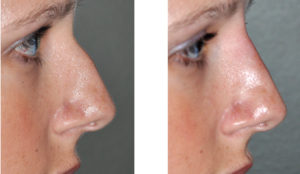
I caution patients about three issues with an injectable rhinoplasty approach. First, the use of injectable fillers (none of them) is approved for injection into the nose area. Therefore, this practice is off label and is not FDA-approved. Secondly and most importantly, the effects created by the injectable fillers is temporary. Over time, the cost of injectable fillers will eventually exceed the cost of a rhinoplasty. If one is looking for a quick fix, this approach may be alright but in the long-term, it is a poor value.
Thirdly and most importantly, there are other better long-term surgical solutions that are more reliable and can address the nose as a whole, rather than one specific area. The implantation of crushed cartilage (from the septum or ear) or the use of off-the-shelf dermal products offers reliable and permanent correction that will naturally become part of your body. Even if this the nasal bridge is the only area of concern, this approach is a better long-term value that will withstand the test of time and is worth the price of rhinoplasty surgery.
Dr. Barry Eppley
Indianapolis, Indiana


